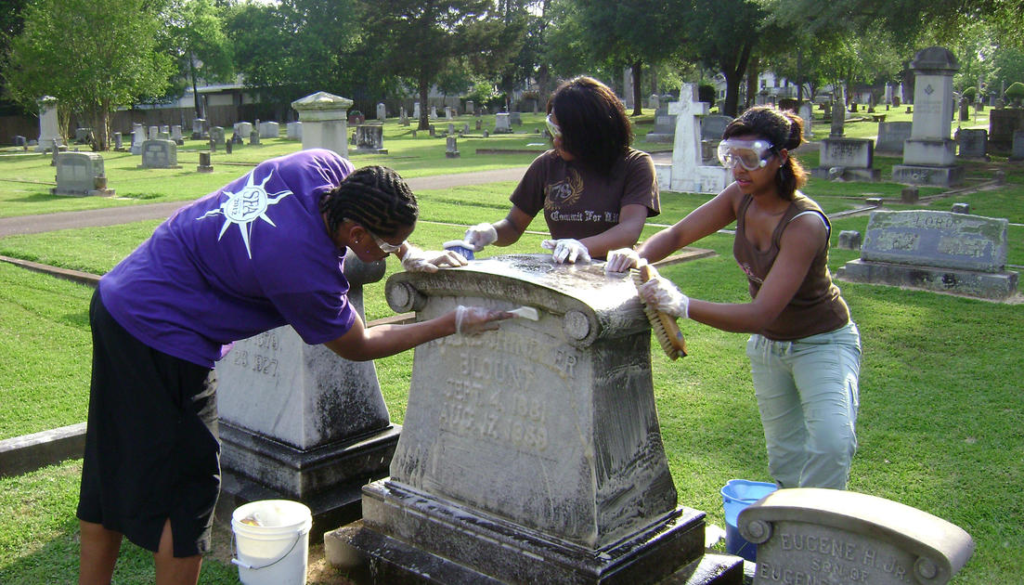Cemetery Preservation Project – How to Organize
Overview
The task of preserving an historic cemetery can be daunting. Often individuals interested in undertaking such a project are overwhelmed and don’t know where to begin. Systematic planning and use of standardized forms and common conservation practices will help an individual or group identify the various aspects of the project, define priorities and scope, as well as assist in creating a reasonable action plan. The following points will help guide those involved early in the project planning.

Establish Ownership to clarify the cemetery preservation project
Establish ownership of the cemetery, or the property surrounding it, before any work is done. In some instances, the cemetery entrance sign will bear the name and owner. However, if this is not the case, the town or county where the property is located will have records that show the landowner and legal property description, usually at the office of the Tax Assessor or Superior Court Clerk. Check local libraries to research any records they may have. Keep in mind that churches often own cemeteries located on or adjacent to their church property.
Know the Laws and Regulations
It is very important to become informed about laws and regulations for cemeteries before beginning work in a cemetery. In many states modern, perpetual care cemeteries are covered under the Secretary of State’s business regulations. Old, historic small or family cemeteries may fall under different sets of laws, which can be found on the Historic Preservation websites. Federal laws may also apply, particularly when military or American Indian burials are present. Keep in mind that numerous state courts have ruled in favor of descendants having the right to decide what is done to their ancestors’ graves, so it is essential to identify and contact descendants for permission to work in a cemetery that does not belong to your family.
Individual cemeteries may have rules regarding the cemetery’s operation and the regulations relating any work to be performed. Information about cemetery-specific regulations is often available from the owner, cemetery association, or “cemetery friends” group. Check with the local government also for local ordinances or cemetery preservation commissions that may have guidelines about cemeteries in their jurisdiction. Additionally, cemetery trade associations can also prove helpful.
Community Awareness and Support of the cemetery preservation project
Build a broad base of community support. Include local elected officials and groups such as historical societies and genealogical groups. Encourage the use of groups such as Boy and Girl Scouts to assist in clean up efforts.
To raise public awareness:
- Use local newspapers to publicize your efforts
- Use the local TV station to highlight your efforts
- Establish a web site with pictures of markers that need attention
- Partner with local schools or communities, which often have volunteer coordinators
- Talk to church groups and garden groups
- Demonstrate to local elected officials that there is something in the project for them
Step One: Get Permission
Obtain written permission to enter the cemetery and to do the work you propose. Keep a written copy of this permission on file. Make certain that all property lines are identified and the accurate boundaries of the cemetery are verified.
Step Two: Formalize interested volunteers into a group
- Establish the group as a cemetery association or cemetery friends group. Alternatively, look in the community for another viable organization with whom the cemetery volunteers can partner.
- Obtain non-profit corporation status from the applicable Secretary of State’s office
- Formalize the group by becoming a 501(c) (3) organization under IRS rules, which will allow the group to receive donations that are tax deductible for the donor.
- Establish an organizational hierarchy with well-defined responsibilities.
Step Three: Conduct surveys
After obtaining landowner and descendant permission, first conduct a simple overview survey, which includes documenting the existence and general condition of the following:
- Present boundaries
- Fences and gates
- Buildings
- Paths and walkways
- Water features
- Family plots
During this survey, identify priority items that need be addressed. Safety concerns must be first on the list. Other points to consider during this first walk through are:
- Identifying previous restoration attempts
- Avoiding disturbance to vegetation, as it may be historically significant.
After the initial survey is completed, vegetation and individual marker surveys may be undertaken to better identify the immediate needs of the cemetery. Use standardized forms and language to ensure consistent information is collected when more than one person is involved in the recordation process.
Step Four: Action Plan
With information gleaned from surveys, draw up an action plan that considers:
- What are the project priorities?
- What type of work force is needed and available?
- What is the minimum amount of work necessary to stabilize the cemetery?
- Will a preservation professional be helpful for guidance, or necessary for certain repairs?
- Examples of short term goals may include:
- Developing a master plan
- Identifying funding sources
- Creating safety guidelines for workers and material artifacts
- Conducting surveys that include photographing, mapping and documenting markers, buildings and ancillary features
Step Five: Funding for cemetery preservation projects
After identifying the cemetery’s needs and setting some goals from which the overall scope of the project can be developed, then funding will be the next consideration. Before seeking outside funds, the cemetery care group should consider taking these steps:
- Obtain a tax ID number and open a checking account, or partner with an existing organization that will handle money for the cemetery
- Establish an endowment account to fund ongoing preservation activity
- Solicit financial support by publicizing the cemetery’s needs to the community and to descendants of people buried there
- Hold fund-raising events in the cemetery and/or regular tours or other educational, fun activities to generate revenue
- Research grants that may be available for specific projects in the cemetery
Step Six: Partnerships for cemetery preservation projects
Partnerships can be useful to cemetery preservation projects by offering both financial and volunteer opportunities. Early on in the project, strive to identify partners and their anticipated contributions, which can be included in the action and master plan.
Partnership suggestions:
- Local historical or genealogical societies
- Programs such as Adopt a Statue or Adopt a Cemetery could generate financial commitments
- School or church groups
- Local building developers that may be committed to “giving back” to the community
- Colleges or schools that have historic preservation programs
- Boy Scout and Girl Scout groups
- Solicit pro bono contributions from lawyers, CPA’s and other professionals
- Special interest organizations such as the Daughters of the American Revolution, Sons/Daughters of the Confederacy, Veterans of Foreign Wars, and other similar groups
Find more cemetery preservation resources HERE and HERE.
Contact us today find out more about our services and for a free quote.
